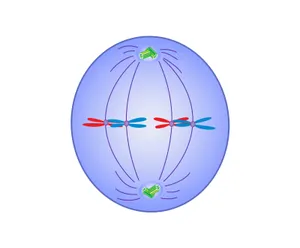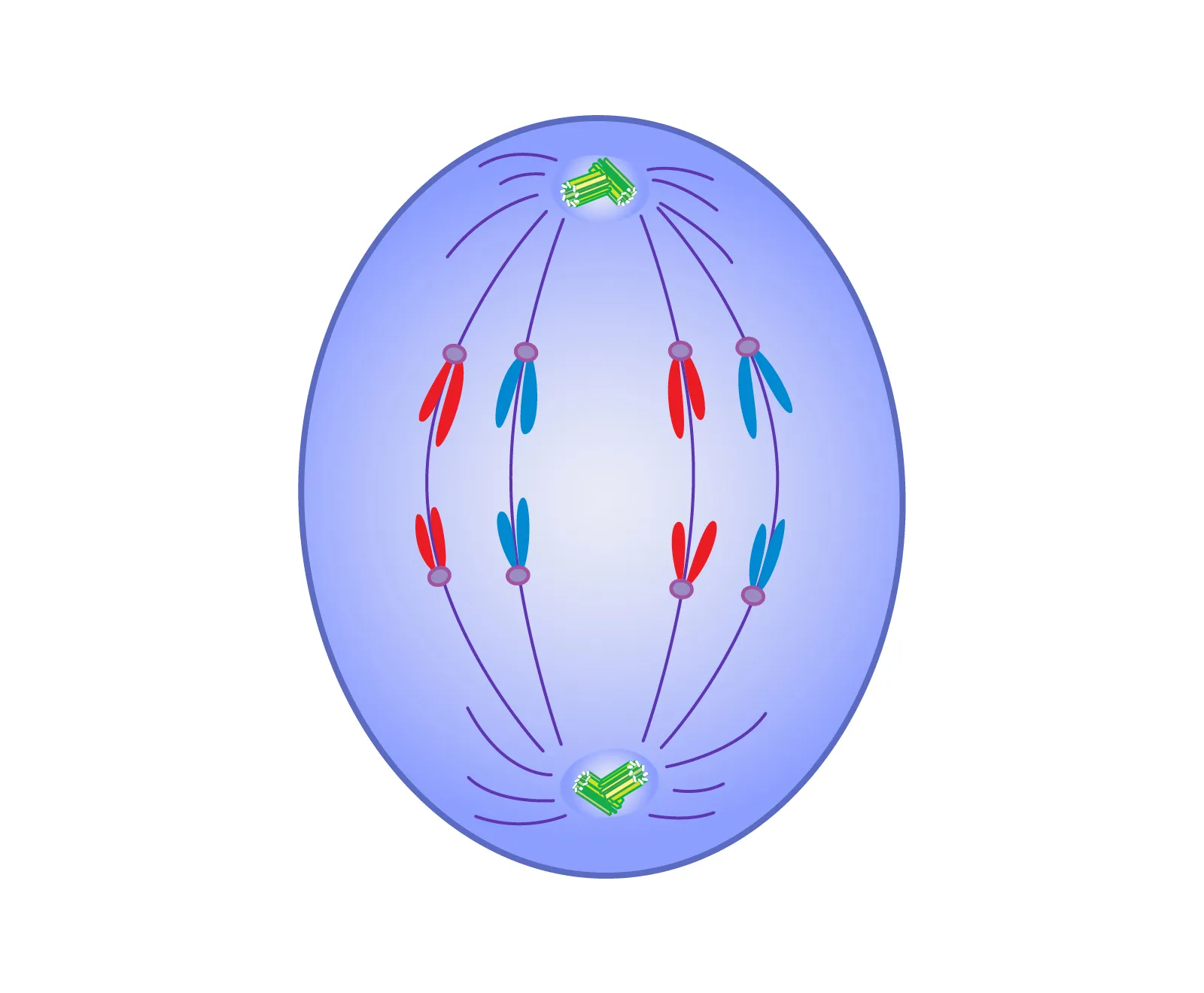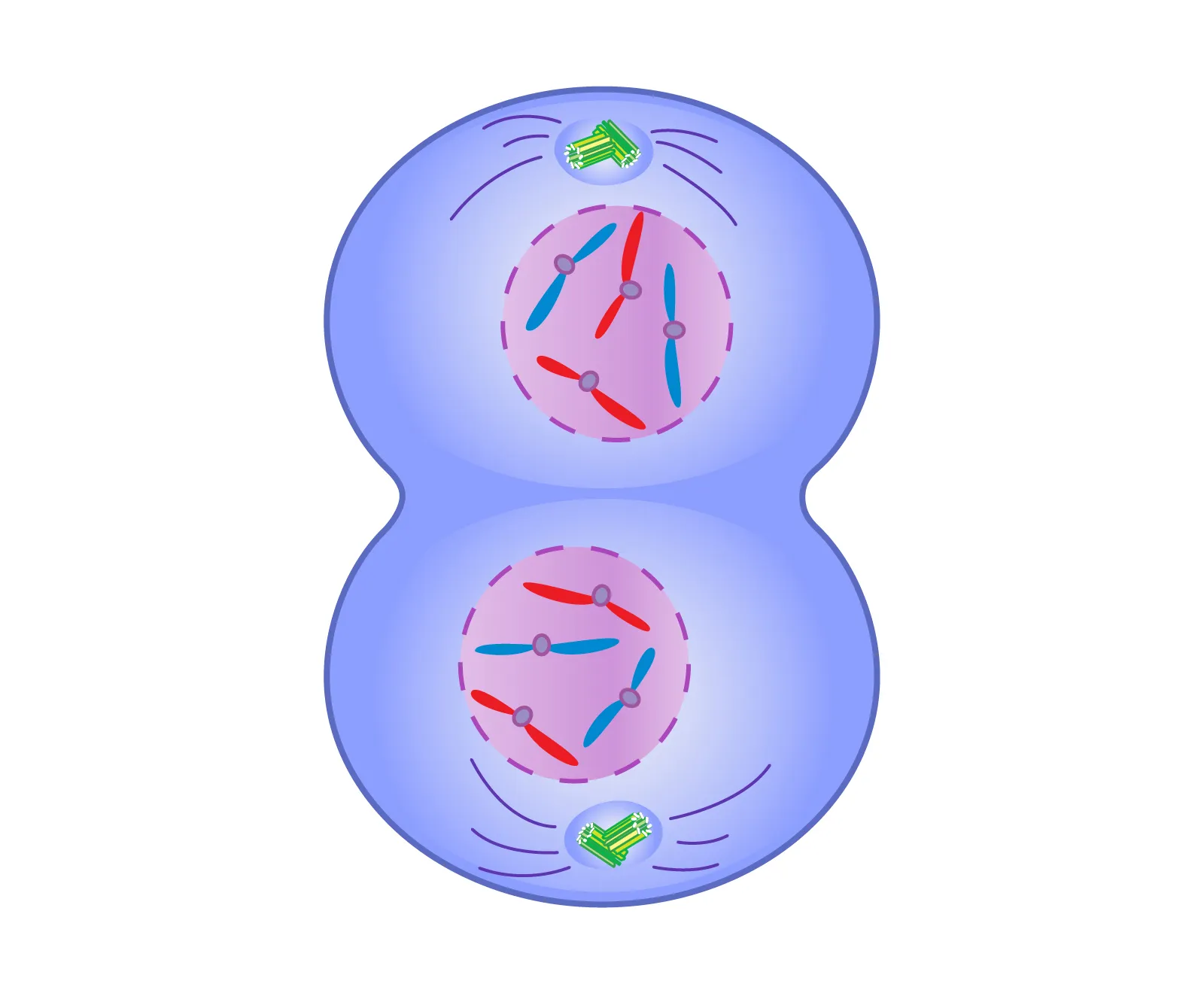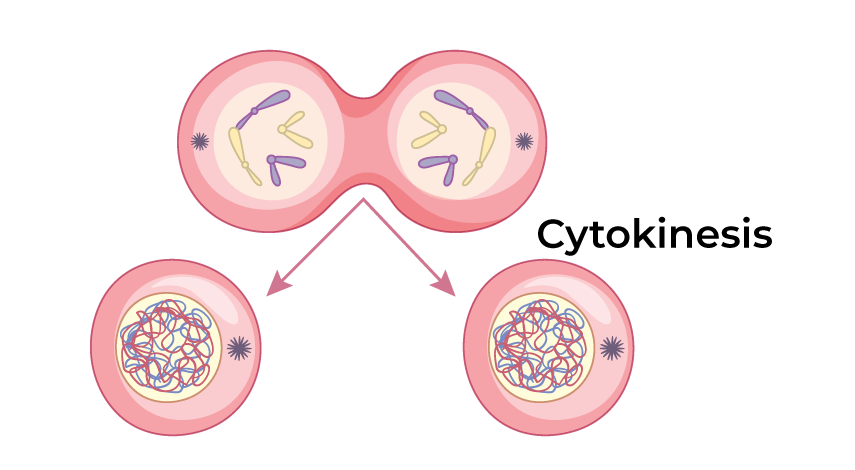Mitosis and Meiosis
1/33
There's no tags or description
Looks like no tags are added yet.
Name | Mastery | Learn | Test | Matching | Spaced |
|---|
No study sessions yet.
34 Terms
proteins in relation to mitosis
Proteins in cells tell you whether cells should divide or not,
EX: hpv is a virus that makes proteins that bind to our proteins that control cell division and tells cells to divide that don’t need to divide
Unicellular
one cell, everytime you make cells you make a new being
Multicellular
if you are multi cellular you use cell division for many things, often multicellular individuals use this for growth, to repair tissues, some creatures are capable for regeneration, reproduction
4 Steps in Division
1.Signal – cells will not divide w/o a signal (ex: growth factors bind to a receptor and tell the receptor which should grow)
2.Replicate- replicate the dna and cellular components
3.Distribution- distribute the replicated material to 2 new cells
4.Membrane separates - form a cell membrane or a cell wall that will separate the 2 new cells
Binary Fission
Prokaryotic are all unicellular, do not have a nucleus, only have 1 circular chromosome, they divide through fission , can replicate in 20 min
Binary Fission- the term for cell division in bacteria (prokaryotes)
only have 1 ori (origin of replication)
Cytokinesis
means that you are separating one cell into 2 and this involves the plasma membrane
eukaryotic division
can divide through mitosis (creates identical clones, generally the way we grow) or meiosis ( a specialized cell division that is only there to produce gametes for sexual reproduction, only make the egg or the sperm)
Chromosomes – have many chromosomes, therefore they have many origin of relplications (ORIs)
Nucleus- extra step compared to prokaryotic, mitosis and meosis deal with replicating genetic material and dividing the nuclei
1.Signal for w/ growth signal for DNA replication (happens in nucleus)
2.Nuclear division of the DNA which will then be packaged into 2 new nuclei
3.Cytokinesis – the division of the plasma membrane (does not happen in all cells for example muscle and embroyonic)
Interphase (prepares for mitosis to begin)

G1: Cell grows, performs normal functions, produces lots of proteins and organelles
S phase: DNA is replicated (chromosomes in the nucleus duplicated). ** cell ends up with 2x as much DNA
G2: once DNA has been replicated, the cell produces many organelles and molecules which will be needed for cell division; centrosomes replicate.
Restriction checkpoints ensure cell is ready to divide (regulated by cyclins and CDKs).
Prophase
Chromatin condenses into visible chromosomes.
Each chromosome is made of 2 sister chromatids held by cohesion proteins.
Nuclear envelope and nuclear lamina break down.
Centrosomes move to opposite poles and form the mitotic spindle.
Kinetochores (proteins at centromeres) attach to spindle microtubul
Metaphase
Chromosomes line up at the metaphase plate (equatorial plane).
Cohesin proteins hold sister chromatids together.
The alignment ensures equal division.

Anaphase
Separase enzyme breaks down cohesion.
Sister chromatids separate and move to opposite poles.
Movement is guided by kinetochore microtubules and motor proteins.

Telophase
Chromatids (now individual chromosomes) reach poles.
Nuclear envelope reforms around each set.
Chromosomes begin to decondense back into chromatin.
Mitotic spindle breaks down.

Cytokinesis
Animal cells: Actin + myosin form a contractile ring, causing the cell to furrow inward and split.
Plant cells: Golgi vesicles form a cell plate in the middle, developing into a new cell wall.

The purpose of Meiosis
To produce gametes (sperm & egg) for sexual reproduction.
Starts with a diploid (2n) cell, ends with four genetically unique haploid (1n) cells.
DNA is replicated once, divided twice.
Functions of Meiosis
Reduce chromosome number from diploid to haploid.
Ensure each gamete receives a complete set of chromosomes.
Increase genetic diversity via crossing over and independent assortment.
Prophase 1 (Reduction Division)
Synapsis: Homologous chromosomes pair up to form tetrads (4 chromatids).
Crossing over occurs at chiasmata, creating recombinant chromosomes.
Nuclear envelope breaks down; spindle forms.
Metaphase 1 (Reduction Division)
Homologous pairs line up at the metaphase plate.
Orientation is random → independent assortment.
Anaphase 1 (Reduction Divison)
-spindle fibers contract and pull homologous chromosomes apart, unlike in mitosis where sister chromatids are separated
-ensures that each gamete will receive one chromosome from each homologous pair, contributing to genetic variation.
Telephase 1 & Cytokinesis (Reduction Division)
-the complete separation of the paired homologous chromosomes to the opposite ends of the cell
-In some organisms, the nuclear membrane re-forms and the chromosomes decondense, although in others, this step is skipped—since cells will soon go through another round of division, meiosis II
-cytokinesis happens at the same time , Results in two haploid (1n) cells, chromosomes still made of sister chromatids.
Asexual Reproduction
A type of reproduction involving mitosis where one parent cell divides to form two genetically identical offspring (clones).
No fusion of gametes.
Used for growth, repair, and some organisms' reproduction.
Produces somatic (body) cells in multicellular organisms.
Sexual Reproduction
Involves meiosis, producing gametes (egg and sperm).
Two gametes fuse to form a zygote, restoring the diploid number.
Generates genetic diversity due to crossing over and independent assortment.
Products are haploid gametes (1n) that combine to form a diploid (2n) organism.
What is the key difference between mitosis and meiosis in reproduction?
Mitosis (asexual): results in 2 identical diploid cells, used for growth and repair.
Meiosis (sexual): results in 4 genetically unique haploid cells, used for gamete formation and genetic diversity.
Somatic Cells vs Gametes
Somatic cells: Diploid (2n), body cells, divide by mitosis.
Gametes: Haploid (1n), sex cells (egg/sperm), produced only by meiosis.
Homologus Chromsome Pair
Two chromosomes (one from each parent) that carry the same genes in the same locations, but may carry different alleles (versions).
They pair up during meiosis, not mitosis.
diploid vs haploid.
Diploid (2n): Two sets of chromosomes (one from each parent). Humans: 46.
Haploid (1n): One set of chromosomes. Humans: 23. Only gametes are haploid.
Meosis 2
•- no replication prior
•Phases are similar (prophase,metaphase, anaphase, telophase) the difference is the cells are now reduced to 1n (haploid), the sister chromatids will separate (happens in anaphase 2) ulitmatley you will end up with 4 cells that are going to be genetically unique/diverse ;
•The 2 things that create genetic dicersity in meosis are going to be crossing over and independent assortment
Aneuploidy
incorrect number of chromosomes (monosomy (missing one), trisomy (have a 3rd and extra one)
trisomy 21= Downs syndrome ; the only aneuploidy that’s not lethal
Nondisjunction (anaphase)
can happen in anaphase 1 or 2, when there is a failure of homologous chromosomes are sister chromatids to separate during anaphase , this will lead to aneuploidy
Translocation
happens when you have synapsing btwn the wrong chromsomes (crossing over occurs with nonhomologous chromosomes )
genetic disorder: Cri du Chat – crossing over btwn 2 chromosomes where babies voice box is deformed and cry sounds like meow
Polyploids
when you have an entire extra set of chromsomes , mitosis can still occur, however the next offspring would be affected , this has resulted in plants and has allowed for evolution of diversity of plants and makes them better
triploid (3n)
tetraploids (4n)
Necrosis (ulcers, messy, infections
yucky/messy cell death, if your cells are damaged/poisoned/infected that is necrosis.
apoptosis
programed cell death which is when you get rid of cells that are no longer needed, if our cells are cancerous p53 (the proteinguardian) recognizes this and gets rid of them
-we also see apoptosis in the embroyo so we don’t have webbed feet and hands (scult embryonic life)
caspases, signaling cascade
chemotherapy
3 Major Life Cycles that Eukaryotes can have
1) Haplontic life cycle- the lifecycle is mostly 1n which is a haploid state
2) Alternation of generations (happens in plants)- they have a 1n life stage that is multicellular and a 2n life stage that is multicellular, and they alternate btwn the 2 during their life; evolutionary as organisms become more complex we see a change in their life style
3) Diplonitc life cycle (what we are used to, includes animals) -- only the gamete will be 1n (haploid)
**classified by how much time they spend in the 1n (1 chromosome haploid) or 2n stages (2 chromosome diploid)